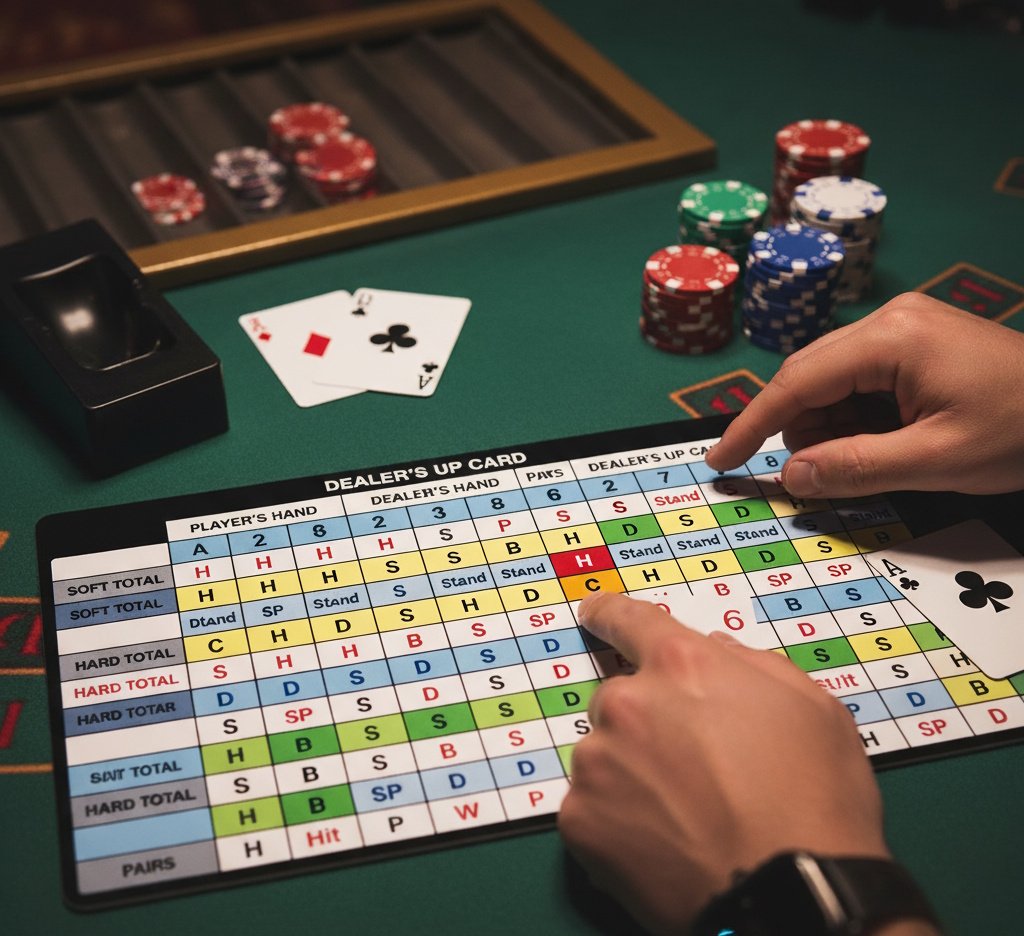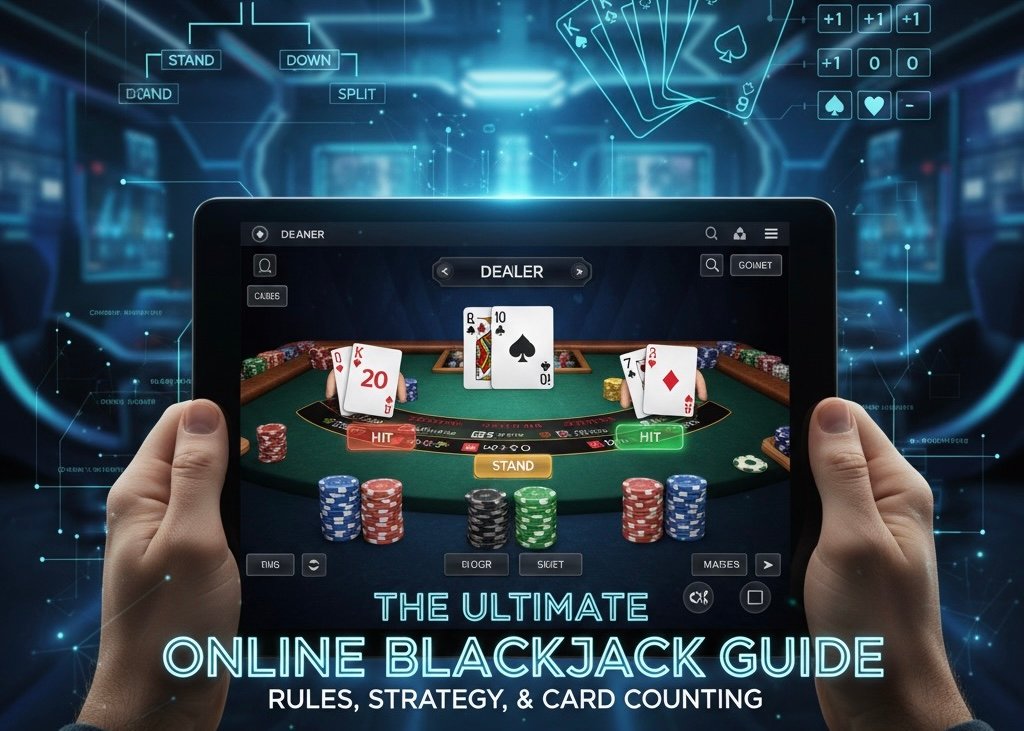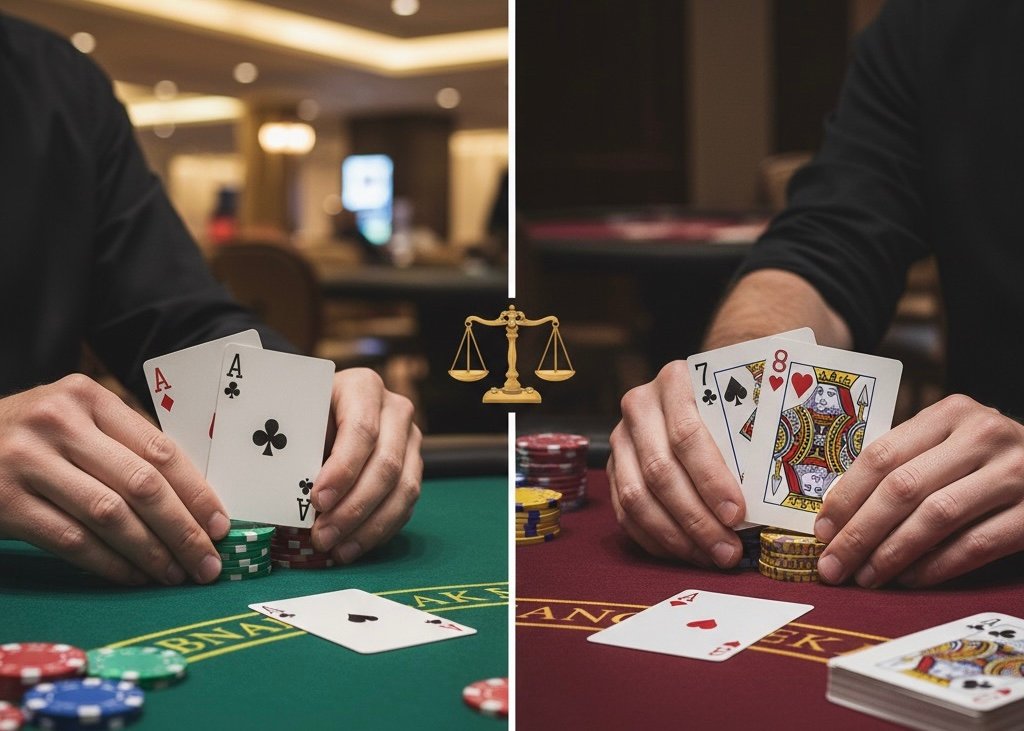Mastering basic blackjack strategy is often portrayed as a complex task reserved for card counters, but the truth is, the majority of the house edge can be eliminated simply by adhering to the Basic Strategy Chart. This document is the cornerstone of successful blackjack play, offering the mathematically correct decision for every hand combination against every dealer upcard.
If you’re ready to move beyond guessing and start making optimal decisions, this guide breaks down the chart’s logic, section by section. For more insights into sharp casino play, visit our main Blog Page.
Highlights
- The Basic Strategy Chart is the statistically optimal decision-making guide for every hand in blackjack.
- By using the chart consistently, you can reduce the casino’s advantage to less than 0.5% (depending on specific rule sets).
- The three main sections to master are Hard Totals, Soft Totals, and Pair Splitting.
- Always consult the dealer’s upcard before making your own decision.
Why the Chart is Essential
The Basic Strategy Chart isn’t based on gut feeling or hunches; it’s the result of countless computer simulations, determining which action (Hit, Stand, Double Down, or Split) yields the highest expected return over the long term.
Imagine a hand of 16 against a dealer’s 7. Your instinct might be to Hit because 16 is a poor total. However, the maths shows that even though you bust frequently, standing (taking no card) results in a larger loss over millions of hands because the dealer’s 7 is a statistically strong card for them. The chart removes this emotional element entirely.
Reading the Dealer’s Upcard
Before you even look at your own two cards, you must look at the dealer’s single exposed card—this is the vertical axis of the strategy chart. This upcard dictates the dealer’s chances of busting or making a strong total.
- Dealer Favourable Cards (2-6): These are ‘Bust Cards’. If the dealer has one of these, they have a higher probability of drawing a ten-value card and exceeding 21. When the dealer shows a 5 or 6, you should look to Double Down if possible, as the dealer is weakest here.
- Dealer Strong Cards (7-Ace): These cards mean the dealer has a high chance of making a good total (17 or higher). When the dealer shows a 7, 8, 9, 10, or Ace, you must play conservatively and focus on hitting a high total yourself.
While understanding this specific rule is vital, it is just one piece of the puzzle. To see how this fits into the broader winning approach, we recommend studying our full breakdown in The Ultimate Online Blackjack Guide: Rules, Strategy & Card Counting.
Hard Totals: The Fundamentals
A Hard Total is any hand that does not contain an Ace counted as 11, or a hand where the Ace is forced to be counted as 1.
| Your Total | Against Dealer 2, 3, 4, 5, 6 | Against Dealer 7, 8, 9, 10, A | Key Action Principle |
|---|---|---|---|
| 17 and above | Stand | Stand | Always stand, regardless of the dealer. |
| 13, 14, 15, 16 | Stand | Hit | This is the crucial ‘stiff’ hand zone. Stand when the dealer is likely to bust (2-6); Hit when the dealer is strong (7-A). |
| 12 | Hit (against 2, 3); Stand (against 4, 5, 6) | Hit | The only exception for standing on a 12 is against 4, 5, or 6. |
| 11 | Double Down | Double Down (unless Dealer shows Ace) | Always Double Down on 11 if permitted, unless the dealer has an Ace (where you should simply Hit). |
| 10 | Double Down | Hit | Double Down when the dealer is weak (2-9); Hit when the dealer is strong (10/A). |
| 9 | Double Down (against 3, 4, 5, 6) | Hit | Double Down only when the dealer is vulnerable. |
Soft Totals: Playing with an Ace
A Soft Total is any hand containing an Ace counted as 11 (e.g., Ace-6 is a Soft 17). The beauty of a soft total is that you cannot bust by hitting, as the Ace can simply revert to a value of 1. The key action here is usually Double Down.
- Soft 19 (A-8) and Soft 20 (A-9): Always Stand. You have a total that is too strong to risk.
- Soft 18 (A-7): This is one of the most frequently misplayed hands. Stand against dealer 2, 7, and 8. Double Down against dealer 3, 4, 5, and 6. Hit against dealer 9, 10, and A.
- Soft 17 (A-6) and below: These totals are generally weak. You should usually Hit, or Double Down against the dealer’s bust cards (3 through 6).
Pair Splitting: Increasing Your Advantage
Splitting pairs is where you can significantly increase your positive expected value, particularly when the dealer is showing a weak upcard.
| Your Pair | Against Dealer 2-7 | Against Dealer 8, 9, 10, A | Key Action Principle |
|---|---|---|---|
| Aces | Always Split | Always Split | The most profitable split in the game. |
| Eights | Always Split | Always Split | Splitting 16 turns one terrible hand into two potentially strong ones. |
| Nines | Split (except against dealer 7, 10, A) | Stand | You have 18, which is a good standing total unless the dealer is extremely weak (2-6). |
| Tens (T, J, Q, K) | Always Stand | Always Stand | Never break a guaranteed 20. |
| Fives | Always Double Down | Always Hit | Treat two 5s as a hard 10; splitting is a mistake. |
| Twos, Threes | Split (against 2-7) | Hit | Split against weak dealers; otherwise, treat as a hard total and hit. |
| Fours | Hit | Hit | Never split 4s. |
| Sixes | Split (against 2-6) | Hit | Split against bust cards; otherwise, hit. |
| Sevens | Split (against 2-7) | Hit | Split against weaker cards; otherwise, treat as a hard 14 and hit. |
Conclusion: Consistency is Key
The core idea behind the Basic Strategy Chart is consistency. You must make the mathematically correct play every time, even if you lose the hand. Over thousands of hands, these small advantages accumulate, dramatically lowering the house edge and keeping you in the game longer.
We encourage all players to view the full range of strategy guides and insights on The Casino Count’s Homepage. Good luck at the tables!
Disclaimer: The content on this page is provided for informational and entertainment purposes only. Blackjack strategy reduces the house edge but does not guarantee success or profit. Gambling involves financial risk, and you should only ever play with money you can afford to lose. Please gamble responsibly.





Leave a Reply